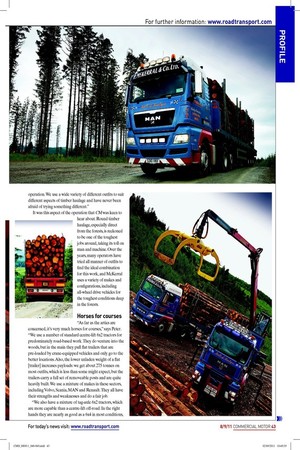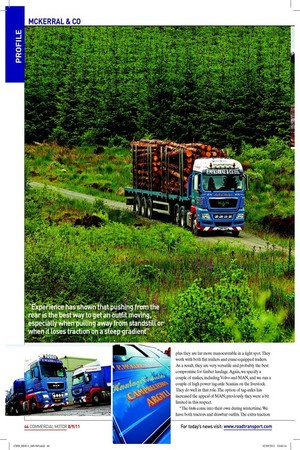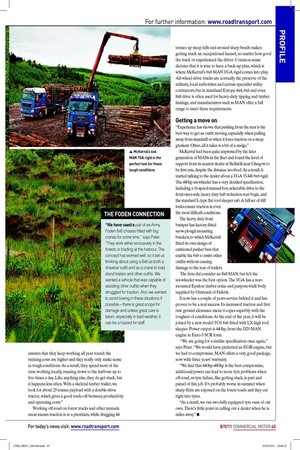Operating a fleet of trucks from a relatively remote rural
Page 35

Page 36

Page 37

Page 38

If you've noticed an error in this article please click here to report it so we can fix it.
location brings its own challenges, not the least of which is a poor road system that adds to journey times and takes its toll in vehicle operating costs. Routes such as these mean a truck might not get into top gear for miles on end, dramatically increasing fuel use compared with hauliers in more central locations, where trucks are on dual carriageways and motorways within minutes of leaving the depot.
With its head ofice at Cambeltown, in Argyll, situated at the bottom of the Kintyre peninsula on the west coast of Scotland, long-established operator P McKerral and Co faces such problems and more every day. The very tip of this strip of land is known as the Mull of Kintyre, a name McKerral proudly displays on the front of its leet in recognition of its roots.
While still part of the mainland, the peninsula has islands on both sides and is roughly parallel with Glasgow and the Central Belt. The 150 miles or so from Campbeltown to Glasgow can take up to ive hours given the poor road system.
McKerral’s transport operation is heavily involved with farming and forestry, two of the main activities in the region, and it has another depot some 50 miles north at Lochgilphead, on the northern section of the peninsula known as Knapdale. This is right in the middle of the forests where much of the timber the company transports originates. Although large quantities of timber now leaves the area by sea, trucks are needed to get it to the ships.
The company is now run by the third generation: brothers Peter, Donnie, Bobbie and Colin McKerral work full time in the business, adapting and innovating to meet the demands made upon it.
Varied specialisations
As well as timber haulage, McKerral specialises in livestock haulage, some ish transport and local and long-distance general haulage.
Eldest brother Peter says: “We have become heavily involved in timber haulage over the years and are continually looking for ways to become more eficient. We have transported livestock for the farming community for generations and run large double-deck articulated outits as well as smaller vehicles.
“We also have a large number of lat trailers that can be adapted for numerous cargoes, along with curtainsiders that are used for other jobs. Nearly all the timber trucks are based at Lochgilphead, where Donnie runs the operation. We use a wide variety of different outits to suit different aspects of timber haulage and have never been afraid of trying something different.” It was this aspect of the operation that CM was keen to hear about. Round timber haulage, especially direct from the forests, is reckoned to be one of the toughest jobs around, taking its toll on man and machine. Over the years, many operators have tried all manner of outits to ind the ideal combination for this work, and McKerral uses a variety of makes and conigurations, including all-wheel drive vehicles for the toughest conditions deep in the forests.
Horses for courses
“As far as the artics are concerned, it’s very much horses for courses,” says Peter. “We use a number of standard centre-lift 6x2 tractors for predominately road-based work. They do venture into the woods, but in the main they pull lat trailers that are pre-loaded by crane-equipped vehicles and only go to the better locations. Also, the lower unladen weight of a lat [trailer] increases payloads: we get about 27.5 tonnes on most outits, which is less than some might expect, but the trailers carry a full set of removeable posts and are quite heavily built. We use a mixture of makes in these sectors, including Volvo, Scania, MAN and Renault. They all have their strengths and weaknesses and do a fair job.
“We also have a mixture of tag-axle 6x2 tractors, which are more capable than a centre-lift off-road. In the right hands they are nearly as good as a 6x4 in most conditions, plus they are far more manoeuvrable in a tight spot. They work with both lat trailers and crane-equipped trailers. As a result, they are very versatile and probably the best compromise for timber haulage. Again, we specify a couple of makes, including Volvo and MAN, and we run a couple of high power tag-axle Scanias on the livestock. They do well in that role. The option of tag-axles has increased the appeal of MAN; previously they were a bit limited in this respect.
“The 6x4s come into their own during wintertime. We have both tractors and drawbar outits. The extra traction ensures that they keep working all year round; the running costs are higher and they really only make sense in tough conditions. As a result, they spend most of the time working locally, running down to the harbour up to ive times a day. Like anything else, they do get stuck, but it happens less often. With a skeletal timber trailer, we look for about 25 tonnes payload with a double-drive tractor, which gives a good trade-off between productivity and operating costs.” Working off-road on forest tracks and other unmade areas means traction is at a premium, while dragging 44 tonnes up steep hills and around sharp bends makes getting stuck an occupational hazard, no matter how good the truck or experienced the driver. Common sense dictates that it is wise to have a back-up plan, which is where McKerral’s 6x6 MAN TGA rigid comes into play. All-wheel-drive trucks are normally the preserve of the military, local authorities and certain specialist utility contractors, but in mainland Europe 4x4, 6x6 and even 8x8 drive is often used for heavy-duty tipping and timber haulage, and manufacturers such as MAN offer a full range to meet these requirements.
Getting a move on
“Experience has shown that pushing from the rear is the best way to get an outit moving, especially when pulling away from standstill or when it loses traction on a steep gradient. Often, all it takes is a bit of a nudge.” McKerral had been quite impressed by the later generation of MANs in the leet and found the level of support from its nearest dealer at Bellshill near Glasgow to be irst rate, despite the distance involved. As a result, it started talking to the dealer about a TGA 33.440 6x6 rigid. The 440hp six-wheeler has a very detailed speciication, including a 16-speed manual box, selectable drive to the front steer-axle, heavy duty hub reduction rear bogie, and the standard L-type lat roof sleeper cab. A full set of diff locks ensure traction in even the most dificult conditions.
The heavy duty front bumper has factory-itted snow plough mounting brackets, to which McKerral itted its own design of cushioned pusher bars that enable the 6x6 to assist other outits without causing damage to the rear of trailers.
The irm did consider an 8x8 MAN, but felt the six-wheeler was the best option. The TGA has a rearmounted Epsilon timber crane and purpose-built body supplied by Outreach of Falkirk.
It now has a couple of years service behind it and has proven to be a real success. Its increased traction and irst rate ground clearance mean it copes superbly with the toughest of conditions. At the end of the year, it will be joined by a new model TGS 6x6 itted with LX high roof sleeper. Power output is 440hp, from the D20 MAN engine in Euro-5 SCR form.
“We are going for a similar speciication once again,” says Peter. “We would have preferred an EGR engine, but we had to compromise. MAN offers a very good package, now with three years’ warranty.
“We ind that 440hp-480hp is the best compromise; additional power can lead to more tyre problems when off-road, as tyre failure, like getting stuck, is part and parcel of this job. It’s probably worse in summer when sharp lints are exposed on the forest roads and they cut right into tyres.
“As a result, we run two fully equipped tyre vans of our own. There’s little point in calling out a dealer when he is miles away.” n












































